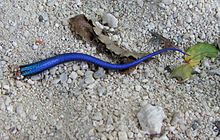Autotomy

Autotomy (from the Greek auto = "self-" and tomy = "severing") or self amputation is the act whereby an animal severs one or more of its own appendages,[1] usually as a self-defense mechanism designed to elude a predator's grasp. The lost body part may be regenerated later.
Reptiles and salamanders


Geckos, skinks, and other lizards, and some salamanders that are captured by the tail will shed part of the tail structure and thus be able to flee. The detached tail will continue to wriggle, creating a deceptive sense of continued struggle and distracting the predator's attention from the fleeing prey animal. The animal can partially regenerate its tail over a period of weeks. The new section will contain cartilage rather than bone, and the skin may be distinctly discolored compared to the rest of the body. The technical term for this ability to drop the tail is caudal autotomy.
Autotomy in lizards is enabled by special zones of weakness at regular intervals in the vertebrae posterior to the vent. Essentially, the lizard contracts a muscle to fracture a vertebra rather than break the tail between two vertebrae. Sphincter muscles in the tail then contract around the caudal artery to minimize bleeding.
Invertebrates

Other animals, such as octopuses, crabs, brittle stars, lobsters and spiders, can also lose and regenerate appendages when necessary for survival. Autotomy occurs in some kinds of octopus for survival and for reproduction: the specialized reproductive arm (the hectocotylus) detaches from the male during mating and remains within the female's mantle cavity.
Autotomic stone crabs are used as a self-replenishing source of food by humans, particularly in Florida. Harvesting is accomplished by removing one or both claws from the live animal and returning it to the ocean where it can regrow the lost limb(s). [2]
Species of (land) slugs in the genus Prophysaon can self-amputate a portion of their tail.[3] There is known autotomy of the tail of sea snail Oxynoe panamensis under persistent mechanical irritation.[4]
Evisceration, the ejection of the internal organs of sea cucumbers when stressed, is also a form of autotomy, and they regenerate the organ(s) lost.
Some sea slugs exhibit autotomy. Both Discodoris lilacina and Berthella martensi will often drop their entire mantle skirt when handled, leading to Discodoris lilacina also being called Discodoris fragilis. The members of Phyllodesmium will drop a large number of their cerata each, on the tip having a large sticky gland that secretes a sticky substance. [5]
Bees
The sting of various honey bee species is a different case; the sting apparatus is modified in such a way that it tears cleanly away from the bee's body, and has its own ganglion that keeps the musculature of the sting shafts moving (thus embedding the sting deeper) and the venom sac pumping for several minutes after it detaches. Unlike most cases of autotomy, the bee dies shortly afterwards (they do not grow a new sting apparatus). All species of true honey bees (genus Apis) have this form of autotomy. No other stinging insect, including the yellowjacket wasp and the Mexican honey wasp, have the sting apparatus modified this way, though they may have barbed stings. The sting of a queen honey bee has no barbs, however, and does not autotomize. Further, the genitalia of male honey bees (drones) also autotomize during copulation, and form a mating plug, which must be removed by the genitalia of subsequent drones if they are also to mate with the same queen. The drones die within minutes of mating.
See also
References
- ^ (2000). The American Heritage Dictionary of the English Language: Fourth Edition.
- ^ Gulf and Florida Stone Crabs
- ^ Mc Donnel R. J., Paine T. D. & Gormally M. J. (2009). Slugs: A Guide to the Invasive and Native Fauna of California. 21 pp., ISBN 978-1-60107-564-2, page 9.
- ^ Lewin R. A. (1970). "Toxin secretion and tail autotomy by irritated Oxynoe panamensis (Opisthobranchiata: Sacoglossa)". Pacific Science 24: 356-358. PDF
- ^ Rudman, W.B. (October 14, 1998). "Autotomy". The Sea Slug Forum.
Further reading
- Pekarinen E. (1994). "Autotomy in arionid and limacid slugs". Journal of Molluscan Studies 60(1): 19-23. Abstract
- autotomy in sea gastropod
